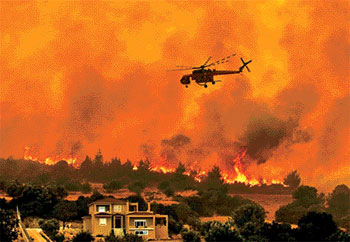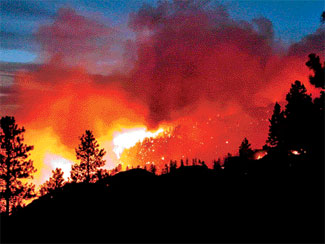|
VARIETY
What causes
wildfires?
Most of you must be aware of the major fires that break out in large
forested areas in various parts of the world destroying vast extents of
land. Both animal and man are adversely affected by these fires that
occur most often without any human intervention. Even in Sri lanka such
fires destroy valuable forest cover. Recently a fire broke out in the
Knuckles Range. Forests are an intregal part of the environment and when
they are destroyed ,the ecological- balance of that region too is
disturbed.
 Let
us find out how such wild fires happen.. Let
us find out how such wild fires happen..
Any uncontrolled fire that satrts in a wild habitat is called a
wildfire, bushfire or forest fire. Such wildfires take place all over
the world. Major fires are reported every few years in the forests of
the United States and Indonesia, and also in the bush in Australia.Wild
fires can happen due to three reasons.
They can be accidental, deliberate( caused by arson ) or by lightning
strikes and volcanic eruptions. Besides these, sparks from rockfalls can
also ignite forest fires. When a heat wave or drought has dried out the
plants in an area a fire sparked off by anyone of the three methods
mentioned here can spread quickly. Because fires can be very
destructive, firefighters have developed lots of strategies for
extinguishing or controlling wildfire. Forest fires happen mainly in the
summer and autumn and are particularly destructive when there is a
drought because branches and twigs die and dry out, creating plenty of
fuel for the fire. Sometimes forest fires can be spontaneous due to hot
and dry weather.
The three essential requirements for fires are oxygen, fuel and heat.
There is no dearth (scarcity) of oxygen in the forest, while the woods
and the dry fallen branches and leaves serve as fuel. So, together they
speed up the spreading of the fire. Besides, it has also been found that
at very high temperatures, woods produce a gas that reacts with oxygen
to ignite a flame. If you are wondering as to how such a fire spreads
across the forest so quickly with its flames virtually swallowing up
everything in its path, it is due to the wind.
The way the wind blows is a major factor when it comes to containing
(restricting) the spread of such fires. Sometimes even firefighters are
unable to take any remedial measures because of strong winds.
Wind is a major factor. Some fires spread along the dead leaves and
branches at the bottom of trees.
 Some
fires spread when the leafy canopy catches fire. Also, burning leaves
and branches can get blown ahead of the main fire causing smaller fires
to start. Planes and helicopters are often used to drop water and
chemical fire retardant into affected ares. Some
fires spread when the leafy canopy catches fire. Also, burning leaves
and branches can get blown ahead of the main fire causing smaller fires
to start. Planes and helicopters are often used to drop water and
chemical fire retardant into affected ares.
But when the fires are blazing and the wind carries the flames higher
and higher into the skies even the planes and helicopters cannot do
anything to control the fires from the air. However, on the ground
firefighters will struggle to contain such fires by creating a control
line an area where they remove all the fuel so that the fire cannot
travel across it.
This can be a barrier like a river or road. They then cut down dead
trees to stop them falling across the fire line.
Drip torches are used to burn the plants between the control line and
the fire to remove the fuel.Generally, wildfires bring negative effects
but you will be amazed to learn that some positive results too could be
obtained from a wildfire. For instance, in the United States they used
to have a policy of putting out all forest fires. However, in the 1960s
they realised that there were no new giant sequoia trees growing. They
grow in the Western USA and have a larger diameter than any other tree
species in the world. Forest fires are a crucial part of their
lifecycle.
Fires take warm air up into the tops of the trees, which dries the
cones and makes them split, allowing the seeds to pop out. Fire also
clears the undergrowth allowing the seeds to germinate. To allow these
processes to continue, the authorities started creating controlled fires
and allowing natural fires to burn. Mild forest fires are often
considered beneficial, as growth of many plant species depend on it.
Many plant species also depend on wildfires for reproduction, as the
exposure to smoke induces germination in these plants.
However, the large forest fires can have serious damaging effect on
the surrounding environment Forest fires can affect climate and weather
a great deal, besides causing severe damage to valuable trees. It can
increase the level of greenhouse gases (water vapour, carbon dioxide,
methane, nitrous oxide, ozone, and chlorofluorocarbons), and thereby
increase pollution and global warming. However, it is an important part
of the ecosystem, and many plants depend on it for growth and
reproduction.
But, too much of wildfires can cause significant damage to the
ecosystem.
Facts: Internet
|

